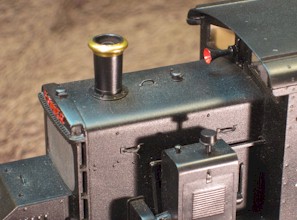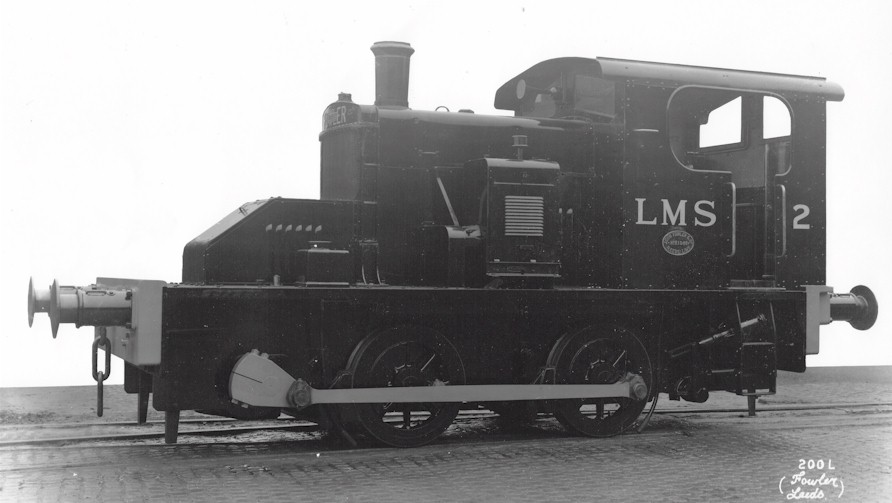
| David L O Smith - Home |
John Fowler Diesel Mechanical 0-4-0 |

A 7mm scale (O Gauge) model of a diesel mechanical 0-4-0 built by John Fowler of Leeds in 1935 (No. 21048) for shunting at the LMS Beeston Sleeper Works in Nottinghamshire, England. The locomotive was powered by a 88HP Ruston engine with a four-speed gear box and jackshaft drive to give a top speed of 15mph. The prototype was scrapped in June 1962 but similar, more powerful locomotives are Osram, at the The Buckinghamshire Railway Centre, and, H.W. Robinson at The Embsay & Bolton Abbey Steam Railway. The GWR owned a similar locomotive with a 70HP MAN engine that was built in 1933 (No. 19451) and sold on in 1940.
I was fortunate to have copies of the GA drawing and the official Fowler works photographs of both sides; these show that the LMS and GWR prototypes differed appreciably. So, although a few of the castings from the Eric Underhill's Vulcan kit of the less powerful locomotive supplied to the GWR were used, this model is mostly scratch built. Insulated frames, split axles and brass wheels centres (individually machined) with pressed on steel tyres provide the pick up. Details that needed to be made (because the LMS and GWR prototypes differed) include the fly-cranks, buffers, starting engine, louvres (punched in 10 thou brass shim with bespoke punch and die in a small fly-press - see Making Louvres below), chimney and air tanks (not cupboards, as suggested in the GWR kit). In addition, detail was added to the radiator core, the footplate and the cab interior; the cab opening also needed to be widened considerably. The drive is from an open frame motor to the rear axle via a worm and 2.5:1 spur gear reduction that makes a realistic diesel mechanical sound.
 |
 |
|
 |
||
|
The larger louvres (example right) required a punch and a die and a some trial and error to achieve the required shape, size and spacing. Although the bolsters that hold the punch and the die are from a small fly-press they were used only to line up punch and die as the louvres were formed by squeezing the two bolsters together with hand pressure alone; the ingenious could probably rig up something sufficient in a (machine) vice. The mild steel punch (RHS in photo below) is shaped for the inside of a single louvre and the mild steel die (LHS) is a deep hole in the shape of a very tall and thin D that is filled with rubber (cut from a pencil eraser). The larger rectangular hole, to the right of the die in the photo, is a recess for the previously formed louvres but the louvre most recently formed is pressed against the left-hand edge of this recess to ensure correct and consistent spacing. A further refinement of the die portion is the two fences that guide an accurately cut strip of shim so that the louvres are formed in line. I also used this arrangement to punch the louvred panels on my model of a Steam Turbine Electric Locomotive. |
|
|
|
|
|
|
|
|
|
|
|
|
||
|
|
|
|
|
At the time I built my model, I knew that the details of the interior of the cab in the Vulcan kit were mere conjecture. However, from the GA drawing, I did know the profile of the control panel and the shape and positions of the rear sandboxes, the handbrake standard and the toolbox/seat, so I fitted these but left the remainder until I could inspect an extant prototype or somebody publishes some drawings or photographs. |
||
|
A somewhat undignified view of the model from below. The open frame motor drives a 2.5:1 spur gear reduction followed by a worm drive to the rear axle (to the right in the photo), which was modified and taken from a Sevenscal L&Y Pug. The jackshaft driveshaft (to the left in the photo) is made in two halves that are connected by an insulated muff within the dummy final drive housing. |
|
|
|
|
The Official Fowler Works Photographs
I did obtain these officially from the holder of the Fowler records in 1991 but they are not marked with copyright information. I would expect them to have copyright protection, though, so please do not assume that you may reproduce them freely. The photographs are about full plate (actually 12” x 10”) so I have scanned them and placed smaller versions here.

Official Fowler Works Photograph

Official Fowler Works Photograph